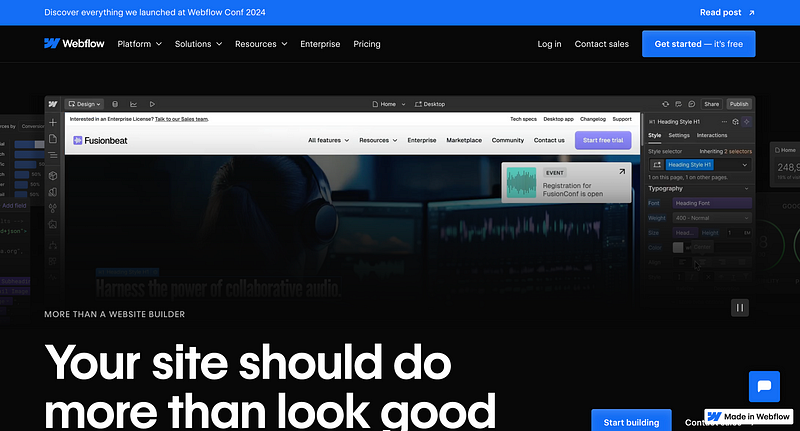Boosting User Engagement with Webflow: A Comprehensive Guide
In today’s digital landscape, user engagement is paramount. With countless websites vying for attention, creating an engaging and…

In today’s digital landscape, user engagement is paramount. With countless websites vying for attention, creating an engaging and interactive online experience is essential for retaining visitors and converting them into loyal customers. Webflow, a powerful web design and development platform, offers a unique set of tools that can help you craft compelling websites without writing a single line of code. In this article, we’ll explore how you can leverage Webflow to increase user engagement on your website.
Why User Engagement Matters
Before diving into Webflow’s capabilities, it’s important to understand why user engagement is crucial:
- Improved Conversion Rates: Engaged users are more likely to take desired actions, such as making purchases or signing up for newsletters.
- Enhanced SEO: Search engines favor websites with higher user engagement metrics like time on site and lower bounce rates.
- Brand Loyalty: An engaging website fosters a positive user experience, building trust and encouraging repeat visits.
Advantages of Using Webflow for Engagement
1. Visual Design Freedom
Webflow’s visual editor allows you to design custom websites without constraints. Unlike template-based platforms, Webflow lets you create unique layouts and interactions that reflect your brand’s personality.
- Custom Animations: Use Webflow’s interactions panel to add animations and transitions that make your site feel dynamic.
- Responsive Design: Ensure your website looks great on all devices, enhancing the user experience for mobile and desktop visitors alike.
2. Interactive Elements
Engagement often comes from interactivity. Webflow enables you to incorporate interactive features that keep users interested.
- Hover Effects: Make buttons and images react to user actions.
- Parallax Scrolling: Create depth by making background images move at a different speed than foreground content.
- Sliders and Tabs: Organize content in a way that’s accessible and engaging.
3. Content Management System (CMS)
Fresh content keeps users returning. Webflow’s CMS allows you to manage and update content easily.
- Blog Posts: Regularly publish articles to provide value and establish authority.
- Dynamic Content: Use collections to display portfolios, testimonials, or product listings that update automatically.
4. SEO Optimization
An engaged user often starts with discoverability. Webflow provides robust SEO tools to help your site rank higher in search results.
- Meta Tags and Descriptions: Customize for better search engine snippets.
- Clean Code: Webflow generates clean, semantic HTML and CSS, which search engines prefer.
- Fast Loading Times: Speed is crucial for engagement, and Webflow’s hosting ensures quick load times.
5. Third-Party Integrations
Enhance functionality and engagement by integrating with other tools.
- Email Marketing: Connect with platforms like Mailchimp to nurture leads.
- Analytics: Use Google Analytics to track user behavior and adjust strategies accordingly.
- E-commerce Solutions: Sell products directly through your website with Webflow’s e-commerce capabilities.
Strategies to Increase Engagement Using Webflow
1. Implement Interactive Storytelling
Use Webflow’s design tools to create narratives that users can interact with.
- Scrolling Effects: Guide users through a story as they scroll.
- Interactive Media: Embed videos and galleries that users can explore.
2. Optimize Navigation
An intuitive navigation system keeps users engaged by making it easy to find information.
- Mega Menus: For content-rich sites, use mega menus to display multiple options at once.
- Sticky Navbars: Keep navigation accessible as users scroll down the page.
3. Personalize User Experience
Tailor content to user preferences.
- Conditional Visibility: Show or hide elements based on user interactions.
- Member Areas: Create login areas where users can access personalized content.
4. Encourage User Interaction
Prompt users to engage directly with your site.
- Forms and Surveys: Collect feedback or lead information.
- Comments and Reviews: Allow users to leave comments or reviews on products and posts.
5. Utilize Social Proof
Incorporate elements that build trust and encourage further engagement.
- Testimonials: Display quotes from satisfied customers.
- Social Media Feeds: Embed live feeds from platforms like Instagram or Twitter.
Best Practices for Maximizing Engagement
- Consistent Branding: Maintain a cohesive look and feel to strengthen brand recognition.
- High-Quality Content: Provide valuable information that meets the needs of your audience.
- Accessibility: Ensure your website is accessible to all users, including those with disabilities.
- A/B Testing: Experiment with different layouts and content to see what resonates best with your audience.
- Monitor Analytics: Regularly review site metrics to understand user behavior and identify areas for improvement.
Conclusion
Webflow offers a versatile platform to create engaging, interactive websites that captivate users. By leveraging its robust features — from visual design freedom to powerful CMS capabilities — you can build a website that not only attracts visitors but also encourages them to interact and convert.
Investing time in crafting an engaging website with Webflow can yield significant returns in user satisfaction and business growth. Start exploring Webflow today and unlock the potential to elevate your online presence.





